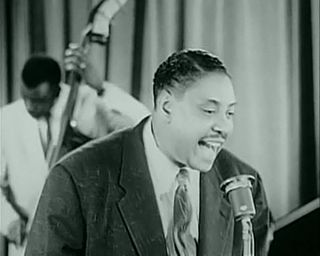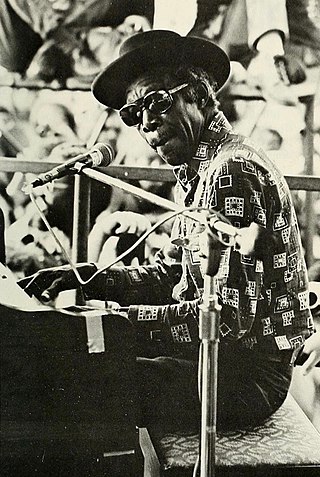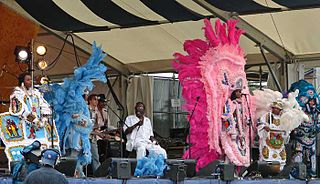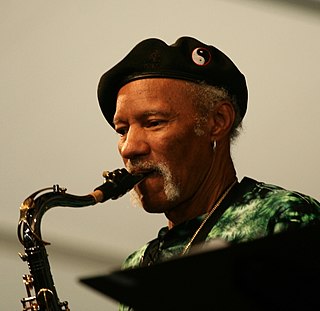
Rhythm and blues, frequently abbreviated as R&B or R'n'B, is a genre of popular music that originated within African-American communities in the 1940s. The term was originally used by record companies to describe recordings marketed predominantly to African Americans, at a time when "rocking, jazz based music ... [with a] heavy, insistent beat" was becoming more popular. In the commercial rhythm and blues music typical of the 1950s through the 1970s, the bands usually consisted of a piano, one or two guitars, bass, drums, one or more saxophones, and sometimes background vocalists. R&B lyrical themes often encapsulate the African-American history and experience of pain and the quest for freedom and joy, as well as triumphs and failures in terms of societal racism, oppression, relationships, economics, and aspirations.

Henry Roeland "Roy" Byrd, better known as Professor Longhair or "Fess" for short, was an American singer and pianist who performed New Orleans blues. He was active in two distinct periods, first in the heyday of early rhythm and blues and later in the resurgence of interest in traditional jazz after the founding of the New Orleans Jazz and Heritage Festival in 1970. His piano style has been described as "instantly recognizable, combining rumba, mambo, and calypso".
Galactic is an American funk band from New Orleans, Louisiana.

The Wild Tchoupitoulas is a 1976 album by the New Orleans Mardi Gras Indian tribe the Wild Tchoupitoulas. While not a commercial success, the effort was well received critically and the experience recording it encouraged the four Neville brothers to perform together for the first time as a group.

Arthur Lanon Neville Jr. was an American singer, songwriter and keyboardist from New Orleans.
Huey Pierce "Piano" Smith was an American R&B pianist whose sound was influential in the development of rock and roll.

Storyville is Robbie Robertson's second solo album. It is focused on the famous jazz homeland section of New Orleans and on that part of the South in general. He contributed one song to Wim Wenders' soundtrack to his 1991 film, Until the End of the World.

Jessie Hill was an American R&B and Louisiana blues singer and songwriter, best remembered for the classic song "Ooh Poo Pah Doo".

Monk Boudreaux is an African-American musician and Big Chief of the Golden Eagles, a Mardi Gras Indian tribe. He is widely known for his long-time collaboration with Big Chief Bo Dollis in The Wild Magnolias.

The Wild Magnolias are a Mardi Gras Indian tribe who also record and play as a funk musical act from New Orleans, Louisiana.

Joseph "Smokey" Johnson Jr. was an American drummer. He was one of the musicians, session players, and songwriters who served as the backbone for New Orleans' output of jazz, funk, blues, soul, and R&B music.

Al "Carnival Time" Johnson is an American singer and piano player best known for the Mardi Gras song "Carnival Time".

Charles Neville was an American R&B and jazz musician best known as part of The Neville Brothers. Known onstage as "Charlie the horn man", his saxophone playing helped earn the group a Grammy Award for best pop instrumental performance.
"Carnival Time" is a New Orleans Mardi Gras-themed R&B song that was performed by Al Johnson and recorded in 1960. The song's composition was originally credited to Al Johnson and Joe Ruffino, though Johnson now holds exclusive rights. It is now considered an iconic festive song of the New Orleans Carnival season.
"Go to the Mardi Gras" or "Mardi Gras in New Orleans" is a New Orleans Mardi Gras-themed R&B song that was performed by Professor Longhair and recorded several times since 1949. He co-wrote the song with Theresa Terry. The song was covered by Fats Domino and released as a single in 1953. It is now considered an iconic festive song of the New Orleans Carnival season.
The Hawketts were an American R&B combo from New Orleans, Louisiana who are best known for their 1954 recording of "Mardi Gras Mambo", a song that has become an iconic classic of the New Orleans Carnival celebration.

John Mortimer Boudreaux, Jr. was an American drummer who was active in jazz, soul, and rhythm & blues idioms.
Cha Wa is a Grammy-nominated Mardi Gras Indian funk band based out of New Orleans, Louisiana. The name Cha Wa is a slang phrase used by Mardi Gras Indian tribes, meaning "we're comin' for ya" or "here we come." Frontman Honey Bannister is known for dressing in traditional Mardi Gras Indian clothing during performances, including intricately designed headdresses.

"Scarface" John Williams was an American R&B singer and Mardi Gras Indian. He performed with the New Orleans band Huey "Piano" Smith and the Clowns.













